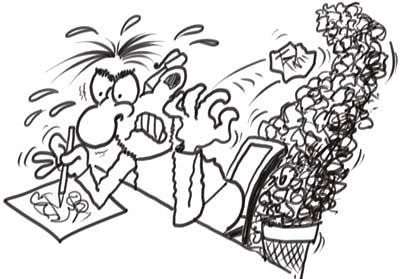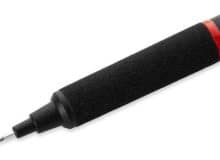How can I improve my drawing skills?
 How to improve drawing skills – 6 Key areas for improvement.
How to improve drawing skills – 6 Key areas for improvement.
Everyone can draw even if it is a simple stick man sketch. But finding the best way to improve and develop that skill can be very frustrating when you are not sure what to do. I wasn’t born with the ability to draw cartoons right off the bat. I had to figure out what was needed and develop skills learned over a long period of time. Over 50 years later I am still learning and finding new ways to improve.
Here are six key areas that I believe will show you how to improve your drawing skills. They work for me and I am sure they will work for you.
Draw what you can’t do – not what you can do!
 Think of a pianist. If they constantly practice an easy piece of music they will master that piece of music and be able to play it to the best of their ability. Great!- Right? Well in one sense yes but if that’s all they practice they will never improve their playing and will only ever be able to play one tune.
Think of a pianist. If they constantly practice an easy piece of music they will master that piece of music and be able to play it to the best of their ability. Great!- Right? Well in one sense yes but if that’s all they practice they will never improve their playing and will only ever be able to play one tune.
This may sound corny and blindingly obvious but most people try to take the easiest route. The only route to successful improvement in your drawing skills is to challenge yourself and practice drawing what you can’t (yet) draw.
If you have a problem drawing hands then practice drawing hands over and over in different positions and keep at it until you can do it. If you struggle with perspective and your drawings look flat or disjointed – get outside and draw buildings, landscapes and study the mathematical concepts of perspective. Painful but very informative. If you need a reference point see my article on 5 great ‘how to draw cartoon’ books for good examples.
 Keep a drawing journal with you at all times.
Keep a drawing journal with you at all times.
There are two reasons for doing this. Idea collection and sketching outside your normal ‘studio’. I get ideas for drawings and cartoons at any time. This is usually just before I go to sleep when an idea for a cartoon suddenly appears from nowhere. I always write it straight into my drawing journal. Why? – because if I leave it till the morning it’s gone.
People are also a great source of ideas and the same thing applies. In conversations I will often get a flash of inspiration from something somebody else has said. It goes straight in the drawing journal before the idea evaporates.
 Drawing outside your normal ‘studio’ is invaluable. Landscape sketches, buildings, people and animals is vital to build up a library for future reference. I keep everything I have ever drawn and still get ideas from things I sketched years ago. You may see an interesting street sign, someone wearing an outrageous hat, a weird looking dog, a quirky house. Anything that catches your eye that could be useful later is worth a quick sketch.
Drawing outside your normal ‘studio’ is invaluable. Landscape sketches, buildings, people and animals is vital to build up a library for future reference. I keep everything I have ever drawn and still get ideas from things I sketched years ago. You may see an interesting street sign, someone wearing an outrageous hat, a weird looking dog, a quirky house. Anything that catches your eye that could be useful later is worth a quick sketch.
If you have a photographic memory you can ignore this tip!
 Practice drawing with a challenge and purpose
Practice drawing with a challenge and purpose
General doodling without a real structure is ok and we all do it sometimes without even thinking. However, if you set a challenge for yourself your brain leaps into a high state of activity as we are naturally competitive even with ourselves!
That may sound crazy but it’s true. If you pitch yourself a challenge you will have more focus, and creative fervour. You will exercise your creative ability and learn and improve at all at the same time.
I have developed a simple drawing challenge in which a random scribble has to be turned into a cartoon and I have used this for all my drawing career. See my article on improving with a quick and easy drawing exercise for the full explanation of how it’s done. I assure you it works!
 Look at other artists and cartoonists work for inspiration.
Look at other artists and cartoonists work for inspiration.
You often hear top musicians saying that they were influenced by the greats such as Beethoven, Elvis Presley and The Beatles. It’s not that they use these people to copy but there is a a lot to learn from people who have trodden the artistic path before you. They set down a template that you can use to emulate their talents.
I have been highly influenced by Walt Disney, Carl Giles (possibly the most famous UK cartoonist) and Schultz (Peanuts) amongst others! I don’t copy their style but have learned a ton from their characterizations, dialogue, storylines, technique, shading, color, use of medium…the list is virtually endless.
I can’t stress enough that you should follow, absorb and learn from people you admire in your field – it really pays off big style!
 Set yourself artistic goals
Set yourself artistic goals
‘You cant manage what you don’t measure’ is more of a business quote but applies strongly to improvement in artistic skills. If there is little structure to your aims and aspirations it is difficult to see how you will progress or how you can gauge improvement because there is nothing to measure.
The simple answer is to ask yourself ‘what improvement in my drawing skills do I want to see in the next six months, twelve months, five years?’ Imagine yourself being able to draw as well as some of your inspirational cartoonists over a given period of time.
Lock that in and then ask – ‘what do I need to do to get there?’ Then set out a plan to achieve it.
One of my earlier goals was to get my cartoons published in a National Magazine. To do this I needed to drastically improve.
 My plan was to do as much free work as possible, which would create deadlines and put pressure on me to get the jobs done. I also made myself practice drawing every single day. It worked and I have had work published in many magazines and books (see right). It took a long time to get there but I got there in the end because I had a goal, I had a process to reach that goal (which was measurable as I could see my progress as I put in more effort) and I also had determination. Determination gets easier to maintain with your goals are set and a plan of action is in place.
My plan was to do as much free work as possible, which would create deadlines and put pressure on me to get the jobs done. I also made myself practice drawing every single day. It worked and I have had work published in many magazines and books (see right). It took a long time to get there but I got there in the end because I had a goal, I had a process to reach that goal (which was measurable as I could see my progress as I put in more effort) and I also had determination. Determination gets easier to maintain with your goals are set and a plan of action is in place.
Just remember this other quote (one of mine) – ‘Procrastination is the mother of detention’. Procrastination keeps you behind and locked in at one level, stopping you moving on and getting better. If you are focussed and have a burning ambition you won’t be caught in artistic limbo!
 Always have your drawing equipment ‘in view’
Always have your drawing equipment ‘in view’
A simple tip – keep your pens, pencils,paper or graphics tablet in your face. If they are neatly stored away out of sight they will be out of mind. Put them where you literally have to trip over them!
There you have it – six tips showing you how to improve your drawing skills. If you follow these you cannot fail to become a better artist.
 Don’t forget to look at my simple drawing challenge exercise to keep your creative mind on high activity
Don’t forget to look at my simple drawing challenge exercise to keep your creative mind on high activity







